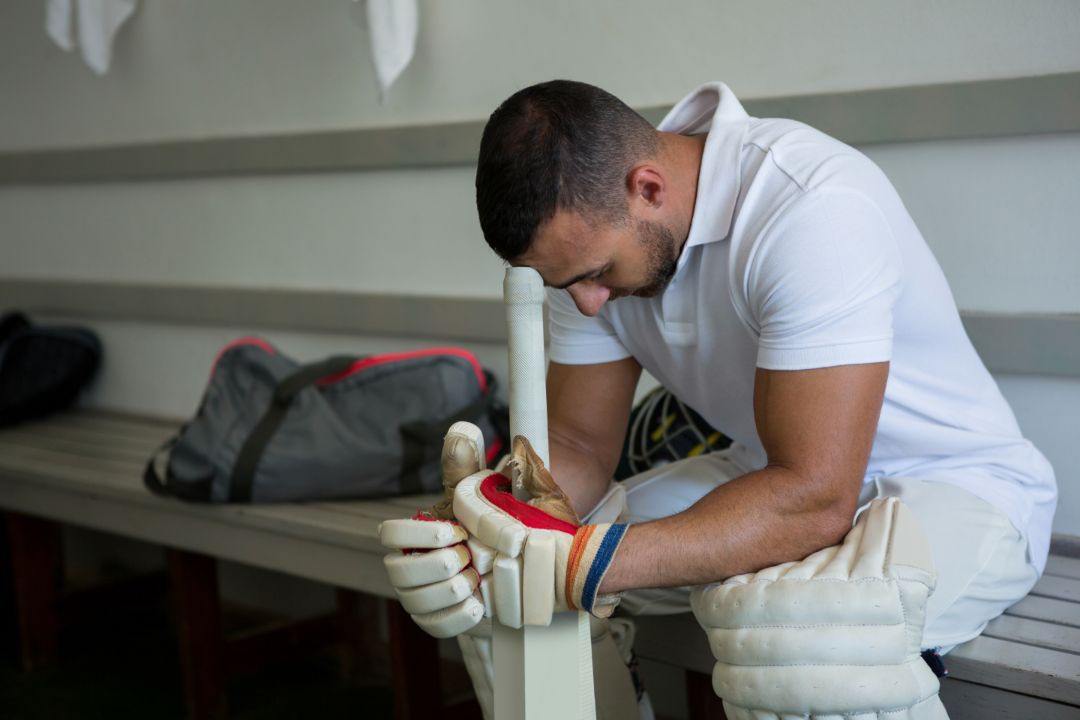Cricket is a popular sport that requires a significant amount of physical activity, with players running, jumping, and repeatedly engaging in upper-body movements. As a result, cricket players are susceptible to a range of injuries, including cricket back stress fractures. These injuries are caused by repetitive spinal strain and can result in significant pain and discomfort and a decreased ability to play the sport.
Understanding the causes, symptoms, diagnosis, and treatment options for cricket back stress fractures is critical for players and coaches.

Photo Credit: LightFieldStudios, Envato
Cricket back stress fractures can be debilitating injuries, and prevention is key for players and coaches. Here are some strategies that can be implemented to prevent these injuries:
Before any cricket activity, it is essential to perform a thorough warm-up. This can include stretching exercises, light aerobic activity, and sport-specific drills. After the training, a cool-down period can gradually decrease the body’s intensity. This can involve gentle stretching and low-impact exercises, such as walking or cycling.
Sports psychology techniques can be employed to reduce stress and improve performance. This can include visualization, positive self-talk, and relaxation exercises. By reducing stress, players can perform at their best without risking injury.
Developing coping strategies can help players manage stress and prevent injuries. This can include time management, goal setting, and stress management techniques.
Injury prevention programs can be utilized to identify areas of weakness and prevent future injuries. These programs can include biomechanical assessment and movement analysis, which can identify areas of the body that require strengthening or flexibility training.
A biomechanical assessment and movement analysis can identify any areas of weakness that may contribute to the development of cricket back stress fractures. Players can prevent future injuries by focusing on strengthening or improving flexibility in these areas.
By implementing these strategies, coaches and players can significantly reduce the risk of cricket back stress fractures. Prevention is always better than cure, and by taking proactive measures, players can stay on top of their game and reduce the risk of injury.
Proper rehabilitation is crucial for recovery from cricket stress fractures. It involves a multidisciplinary approach, including ergonomics, load distribution, orthopedics, and sports nutrition. Each athlete’s situation is unique, and therefore rehabilitation must be tailored to individual needs.
Several factors, including calcium intake, vitamin D, bone density, flexibility training, cross-training exercises, and resistance training may influence the rehabilitation process for cricket stress fractures. It is essential to work with a team of medical professionals to ensure that the rehabilitation program is specifically designed to meet individual needs based on these factors.

Photo Credit: Wavebreakmedia, Envato
The rehabilitation timeline for cricket stress fractures will vary depending on the severity of the injury. However, it typically includes several stages, each with its own set of goals. These stages may include rest, controlled loading, the reintroduction of activity, and gradual progression to full participation in cricket. The timeline should be carefully monitored to avoid further damage to the injured area.
Gradual progression is critical when rehabilitating from cricket stress fractures. This is because the bone needs time to adapt and strengthen to the stresses placed upon it. Overexerting an injured bone can lead to reinjury, resulting in further time away from the sport. A gradual progression program that includes prescribed exercises and rest periods will help to ensure a safe return to cricket.
It is important to remember that the rehabilitation process for cricket stress fractures is unique to each athlete. A qualified medical professional should design and monitor the program to ensure the best possible outcome for the individual.
Cricket, like any other sport, poses the risk of sustaining injuries. Back stress fractures are particularly common in cricket, and various factors can influence their occurrence. Understanding these factors can help players and coaches prevent these injuries and ensure timely management.
Cricket is played on different pitches, and ground hardness can vary depending on several factors. More challenging grounds can cause more stress to players’ backs, increasing the likelihood of stress fractures. Additionally, the bowling and batting techniques can contribute to back injuries, making players susceptible to stress fractures.
Age-related and gender-related factors can impact the risk of cricket back stress fractures. Players over 30 years old are at higher risk of back injuries than younger players due to decreased bone density. Female players have a higher risk of back injuries than male players due to differences in body mechanics and hormonal factors.
The type of footwear worn by players can also play a crucial role in the risk of back injury. Footwear with inadequate shock absorption can increase the stress placed on the back, making players more susceptible to stress fractures. Players must select footwear that offers support and cushioning to prevent back injuries.
It is essential to note that multiple factors can contribute to the risk of back stress fractures in cricket. Therefore, it is crucial to identify and manage these risk factors to prevent their occurrence. A proper understanding of these factors can help players and coaches create comprehensive injury prevention programs that include biomechanical assessment and movement analysis to minimize the risk of back injuries and stress fractures.
Preventing cricket back stress fractures is crucial, but managing and monitoring these injuries is just as important. Proper injury management and monitoring strategies must be in place to minimize the risk of re-injury and ensure a safe return to play.

Photo Credit: chormail, Envato
One of the key factors in injury management is effective physical workload monitoring. This involves tracking the amount and intensity of physical activity a player is undertaking and adjusting it accordingly. Coaches and medical staff must monitor the player’s training and playing schedules and give them the appropriate rest and recovery time. This approach helps to avoid overuse injuries and prevents any further accumulation of micro-trauma that may lead to stress fractures.
Rest and rehabilitation are crucial for recovery from stress fractures. Proper rest and rehabilitation involve a combination of ice and heat therapy, physiotherapy, and medication to reduce inflammation and pain. Medical staff may also use orthotics such as braces and casts to immobilize the injury site and promote healing.
The return-to-play process should always be gradual and carefully monitored. Players must not return to full activity until they fully recover from the injury and regain their fitness. A gradual approach involves a step-by-step increase in physical activity, focusing on quality over quantity. Pay attention to the body’s response to the increased activity and intervene early if any discomfort or pain is experienced.
Biomechanical efficiency plays an essential role in preventing re-injury. Coaches and medical staff need to closely monitor players’ movement patterns and identify any areas of weakness or poor technique. Addressing these issues can improve the player’s biomechanics and reduce the stress on injury-prone areas. This approach helps players return to the sport with a lower risk of future injury.
In conclusion, proper monitoring and injury management strategies can help prevent re-injury and ensure that players return to the sport with minimal risk. Physical workload monitoring, injury management strategies, gradual return to play, and biomechanical efficiency are critical components of an effective injury management and monitoring program.
In conclusion, cricket back stress fractures, particularly in the “pars interarticularis” area of the spine, represent a significant concern, especially among cricket fast bowlers and other athletes engaged in sports involving high training loads and repetitive loading on the spinal column. These fractures are often considered one of the weakest points in the spinal column, making athletes vulnerable to stress-induced injuries.
Early diagnosis is paramount, and this typically involves accurate assessments by physiotherapists, orthopedic surgeons, and sports medicine experts. Diagnostic tools such as radiographs, bone scans, and CT scans can provide invaluable insights into the extent and nature of the injury.
It’s important to note that chronic pars defects may also occur in growing athletes whose skeletal structures have not yet fully developed, increasing the risk of injury. Training programs that emphasize sports-specific techniques and progressive strengthening, particularly in extension and rotation, are crucial for mitigating the risk of stress fractures in these athletes.
Patients with severe or persistent pain may require surgical intervention, but a graded return to regular training with lower limb strengthening and addressing any technique issues should be a part of the rehabilitation process. Over-training and inadequate recovery periods can exacerbate the condition, so careful management of training load is essential.

Photo Credit: microgen, Envato
In summary, cricket back stress fractures are a type of injury that can have significant implications for athletes in cricket and other sports that involve repetitive loading of the spine.
Timely and accurate diagnosis, coupled with appropriate management strategies such as progressive strengthening and sports-specific training, can help athletes recover and return to their chosen sports without the need for surgery, ultimately ensuring their long-term well-being.
Collaboration between physiotherapists, orthopedic surgeons, and sports medicine professionals, as well as a focus on injury prevention, are critical components of addressing this issue effectively.
Cricket back stress fractures can be caused by repetitive stress on the lower back, especially during activities involving spine rotation. Fast bowlers in particular are at a higher risk due to the repetitive motion involved in their bowling technique.
The common symptoms of cricket back stress fractures include lower back pain that worsens with activity, especially during fast bowling. There may also be tenderness over the affected area and pain with certain movements, such as hyperextension or flexion of the lower back.
Diagnosis of cricket back stress fractures is usually done through imaging techniques such as X-ray or MRI. MRI may be more effective in detecting early signs of stress fractures or spondylolysis.
Spondylolysis is a common cause of back pain, particularly in adolescent athletes. It refers to a defect in the pars interarticularis, a bony structure in the lumbar vertebra. It can lead to stress fractures and even spondylolisthesis if left untreated.
Symptoms of a lumbar stress fracture, often in the “pars interarticularis” area of the spine, can include low back pain that worsens with lumbar rotation or activities like gymnastics. Pain can localise to the lower back or radiate to the lower limbs. In young athletes, these fractures are usually symptomatic.
The healing time for a lumbar stress fracture varies, but it typically takes several weeks to months. The exact time depends on factors like the severity of the fracture, the individual’s overall health, and the effectiveness of treatment.
Treatment for a lumbar stress fracture usually involves rest from activities that strain the lower back, like gymnastics, to allow the bone to heal. Physical therapy may be used to improve posture and strengthen the back and core muscles. In severe cases, bracing or surgery may be necessary.
Yes, many people with lumbar stress fractures can still perform activities of daily living, including walking. However, activities that place stress on the lower back or cause axial loading should be avoided to prevent further injury and allow healing. The activity level depends on the fracture’s severity and the individual’s pain levels.